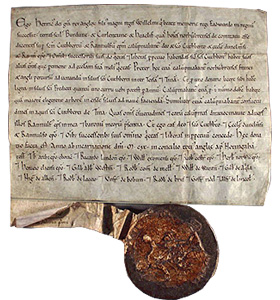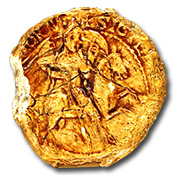| |
|

|
|
The oldest surviving
Scottish royal charter
|
|
The charter echoes certain forms
found in Anglo-Saxon diplomas and contemporary
Norman charters, using `Ego' at the beginning,
with a moderately elaborate royal style, and
concluding with an anathema (`Qui autem
istud uoluerit destruere. uel ministris sancti
cuthberti aliquid inde auferre;
maledictionem dei. et sancti
Cuthberti. & meam; habeat. amen.'
It records that the king has given `in
elemosina' lands in Lothian with all the service
that Bishop Fothad (of St Andrews) had from
them, `in tali quie tan tia cum
saca & soca. qualem unquam
meliorem habuit sanctus
Cuthbertus. ab illis de quibus
tenet suas elemosinas', this for (the spiritual
benefit of) himself, the soul of his father, his
brothers, wife and infants, making the common
distinction between the living and his dead
father with his soul mentioned. Wishing the gift
to be stable he has made his brothers confirm.
Twelve crosses, each with an associated name,
were written below the text, and then there is a blank space of
some 100 mm. to the foot of the document.
|
|


